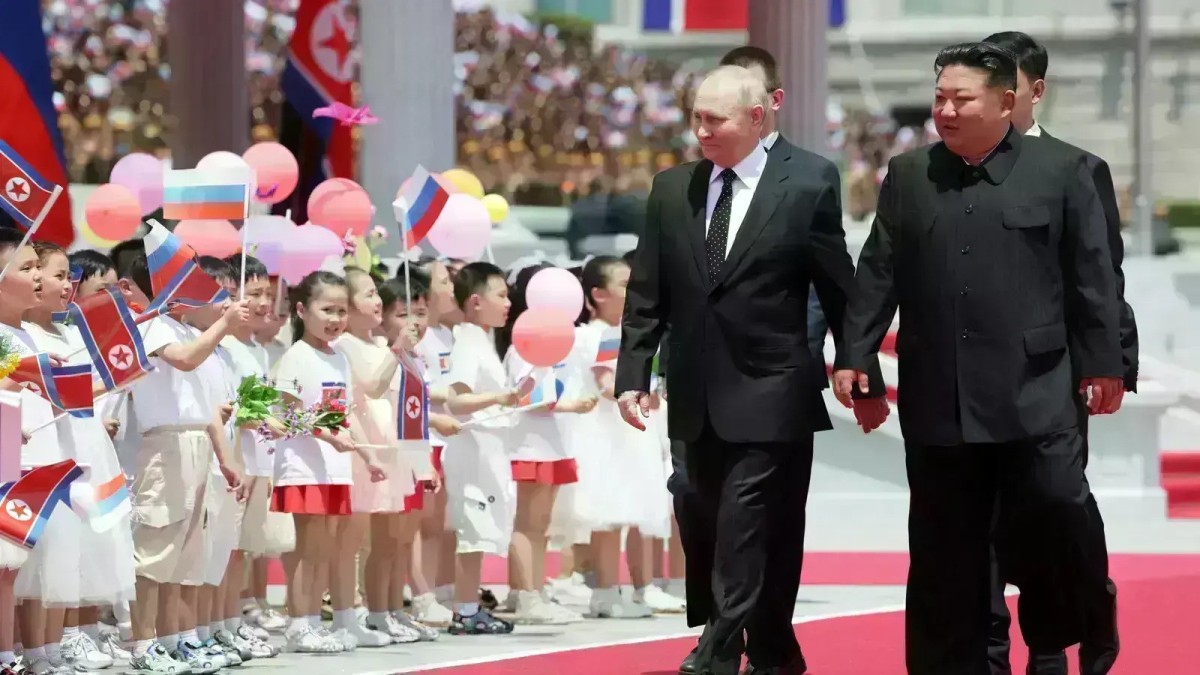Russian President Vladimir Putin’s visit to North Korea (18–19 June 2024) has attracted global attention. Today, both of these states are keen to cooperate to overcome the sanctions put on them by the US. This is Putin’s only second-ever visit to Pyongyang, with the first taking place way back in 2000. Obviously, a lot has changed during the last two decades or so. North Korea’s other good friend, China, has welcomed this visit.
Russia has always been important to North Korea. However, during the last few years, not much has happened towards any noteworthy engagement. During the 2018–19 period, the North Korean leader Kim Jong Un was found engaging China proactively, and between the period of March 2018 and January 2019, he visited China four times. Also, around the same period, he met US President Donald Trump. Actually, Trump became the first sitting US president to visit North Korea in 2019.
Unfortunately, no efforts to engage North Korea have proved successful so far, and the only major countries that have cordial relations with North Korea remain its neighbours, namely Russia and China.
The recent increased bonhomie between Russia and North Korea could be said to have started with North Korean leader Kim Jong Un visiting Russia in September 2023. Today, both of these states need each other much more than in the past. Moscow has some dependence on Pyongyang for supplies of arms and ammunition for fighting the war in Ukraine. While North Korea has a dependence on food and energy assistance, interestingly, it is also depending on Russia for assistance in its space surveillance programme.
When Kim Jong Un visited Russia in September 2023, he was assured by Putin of his assistance in the space domain. During the year 2023, North Korea made three attempts to launch a spy satellite in space. The attempts during May and August 2023 had failed, while the attempt during November 2023 was a success, with North Korea putting its first spy satellite, the Malligyong-1, on the back of its own Chollima-1 launch vehicle in space. Since during Kim Jong Un’s September 2023 visit to Russia, there was a promise made for assistance in the space sector, there is a possibility that for the November 2023 launch, some Russian assistance was there.
Impact Shorts
More ShortsUnfortunately for North Korea, its recent launch (on May 27, 2024) to put up a military reconnaissance satellite (Malligyong-1-1) ended in failure. For a nuclear weapon state like North Korea, it is a necessity to have a mechanism for gathering real-time intelligence. Hence, it has interests in spy satellites. It is keen to establish a space-based architecture that offers intelligence, surveillance, and reconnaissance (ISR) capabilities. For this purpose, it wants to have increasing assistance from Russia in the space domain.
The potency of North Korea’s nuclear deterrence structure would depend not only on the number of nuclear weapons in its kitty but also on various factors, like having capable missile systems to deliver the weapons correctly to the target. At the same time, it needs to guard its state from any attack by its adversaries. Hence, space-based ISR systems are important both for defence and offence purposes.
There are reports indicating that North Korea has developed several types of unmanned aerial vehicles (UAVs) for ISR purposes. However, there are limitations in regards to the types of sensors in use. Also, endurance and communications restraints limit its utility.
North Korea is keen to expand its space program. It understands that there is a ‘global’ watch on its space and missile programs. The South Korean and US investigators have analysed the recently failed (2023) two launches by North Korea. In its estimation carried out by analysing the recovered parts from these launches (fallen in the ocean), the North Korea payloads had ‘no military use’. This indicates that North Korea needs to improve on sensor technologies, satellite design and development capabilities, and rocket launch capabilities.
Today, various activities undertaken by North Korea are being continuously monitored by the US with the assistance of Japan and South Korea. The US has the Combat Sent and the Cobra Ball systems for gathering electronic intelligence. It is known to carry out ‘air espionage’ of the area from which North Korea is launching its space launches and undertaking ballistic missile testing.
These systems are part of the RC-135 family. The US Air Force flies aircraft for the purpose of ‘measurement and signature intelligence’ collection. It is able to monitor ballistic missile flights at long range. North Korea is not keen to expose the trajectory of its technology development to its advisories. It feels that with Russian assistance, it can leapfrog.
North Korea understands the importance of command-and-control systems for its nuclear weapon architecture. It needs satellite technologies urgently, and Russia could significantly assist them in advancing its spy satellite program. One important component of Putin’s visit to North Korea is about quid-pro-quo dynamics. It could be a trade-off where Russia provides satellite technology in exchange for military weapons or equipment from North Korea.
The author is Deputy Director General, MP-IDSA, New Delhi. The views expressed in the above piece are personal and solely those of the author. They do not necessarily reflect Firstpost’s views.


)

)
)
)
)
)
)
)
)



